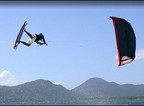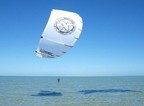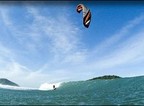In utilizing the wind’s power to travel as quickly as achievable across the water and high into the air, kitesurfing falls somewhere between kiting, windsurfing and wakeboarding. Standing on boards similar to wakeboards but fitted with kitesurf kites, kitesurfers try to jump into the air and do other stunts although they ski over the water. A safety vest, guards for heads, knees and elbows and an emergency line-cutter are necessary safety equipment for any kitesurfer.
- Acquire a simple knowledge of water sports before you begin using kitesurf kites. Either take lessons or use your encounter in previous water sports to assist you. For those who can water-ski or have been on a wakeboard you will be far better prepared for becoming towed by kitesurf kites and windsurfers will know how you can use wind strength for performing tricks and jumps.
- Newbies typically get into trouble when they misjudge distances and wind speed. Several sessions with an International Kiteboarding Organization certified instructor is advised for any prospective kitesurfer.
- Only kitesurf in places earmarked for kitesurfing and look out for shallows, buildings or power lines within the location to assure your kitesurf kites don’t get entangled. And usually check the weather forecast prior to you leave house to ensure that you don’t get caught in a gale.
- Kitesurfing is only for powerful swimmers. A life jacket is only a safety device and cannot get you back to shore or swim you to your control bar if your kite has taken off without out. As an further precaution, generally maintain kitesurf having a buddy who can look out for you.
Standard kite-surfing kit consists of:
- Boards: Important considerations when deciding on your board are the wind speed at your favorite kitesurfing location, your physique weight and your level of skill. Beginners do much better on wide boards that remain afloat longer and may be fitted with smaller kites. They also make it less difficult to sail upwind.
- Smaller boards for much more experienced kitesurfers facility performing tricks as a lot more kite power could be employed. Even though they look a bit like wakeboards, smaller kitesurfer boards commonly have concave bottoms and step strategies for much more powerful rides, are flatter and have difference rocker systems. Boards are fitted with bindings or shoe-like straps that will be readily attached or detached for sailing or doing stunts.
- Control Bars: Kitesurfers steer their kites by holding onto the ends of the control bars that are attached to the lines operating up to the kitesurf kites. They are heavy in order to play with the wind and have floats to stop them from sinking.
- Harnesses: Attached to the control bars, harnasses allow kite surfers to carry out tricks even though remaining attached to the kitesurf kites. You will discover waist harnesses for professional kite-surfers and for beginners, seat and vest harnesses, diminishing impact and usable as flotation devices. Harnesses assist to distribute the stress of the kite’s force from the kite-surfer arms towards the rest of their body.
- Grabs: The starting point of board-off tricks grabs are performed by jumping and taking your back hand off the control bar though you might be inside the air; Nnext, pull the board towards your body and grab it with your back hand. Then release the board and land.
- Spins: The number of spins probable is determined by your spinning speed and the jumping period. Jump and turn your head and shoulder in the spinning direction. Once the spins are completed, turn your head and shoulders within the opposite direction and prepare your legs to land.
- Inverts: To turn upside down, lift your feet into the air as soon as you will be airborn.


